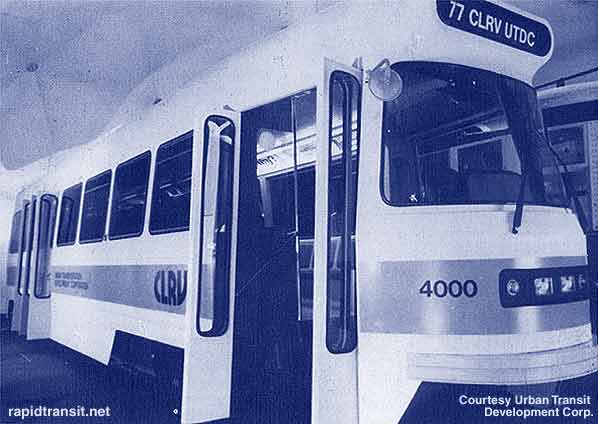|
Light Rail Notes
by James Seamon Page
2

Canada's Standard Light Rail
Vehicle
Add Toronto to the North American
cities that have placed firm orders for new light rail equipment. Two
hundred cars like the exhibit car above (at the Canadian National Exhibition)
have been ordered from the Urban Transportation Development Corporation.
The meeting, presented by the Transportation Research
Board (formerly the Highway Research Board), was well covered by the press
and other media. Other sponsors included UMTA, the APTA, and the
University of Pennsylvania.
Several streetcar museums
were represented, but only a few remarks were heard about the "good old
days." Most participants were concerned about Light Rail's future as a
viable alternative for medium density transit corridors, in cities of
various sizes.
Dayton,
Ohio
, has a plan for
Light Rail Transit, and is ready to begin construction as soon as Federal
funding is assured.
San
Francisco, of course, is working on its Light Rapid Transit line
beneath Market Street, and both San Francisco and Boston have new cars on
order. Shaker Heights and Pittsburgh have recently refurbished their PCC
equipment, and Philadelphia is beginning a rebuilding program, as is
Toronto.
SLRV Test Ride in
Boston
In the wee hours of the
morning of July 12, 1975, 1 rode Boeing's Light Rail Vehicle test car on
the Massachusetts Bay Transportation Authority's Riverside Line in
Boston.
Tests were conducted on the
western end of the grade-separated line, over a section of rebuilt track
complete with continuous welded rail. The test runs were made without
passengers, a full operating load being simulated with sand bags.
The car ran a series of
starts and stops to simulate operation
on San Francisco's Market Street Line. The MBTA track is in excellent
condition, and the old PCC car on which I came out rode very well even at
speed. Even so, the Boeing car was noticeably smoother with its air
suspension.
Although the Boeing car's
acceleration was not as fast as the PCCs, it still performed quite well.
Braking was impressive, with the dynamic braking system holding high
current down to zero speed. This is a real improvement over traditional
dynamic braking, which fades badly at low speed.
Boeing used a traditional
trolley pole to get into and out of the yards, but used pantograph
operation on the main line.
I
found the car generally impressive, with one glaring design error. The
windshield is so near to true vertical that night operation is impossible
unless black cardboard is hung behind the operator's compartment to
eliminate glare from the interior lighting. Later model PCC cars had
sloped windshields that eliminated this problem.
The Boeing crew is largely
aerospace and electrical engineers, some of whom would prefer to get back
to aircraft work. Both the Boeing crew and MBTA people were very friendly
and helpful (I had previously cleared with MBTA headquarters by letter).
The MBTA people are sold on light rail, and very proud of the Riverside
Line.
The
MBTA plans to operate the articulated Boeing cars in two-car trains, which
will equal current threecar PCC trains in overall length.
* *
*
© 2000 by The Composing Stack Inc. Not responsible for
typographical errors.
The Third Rail and The Third Rail
logo are trademarks of The Composing Stack Inc.
.
|

